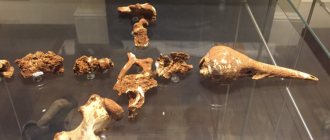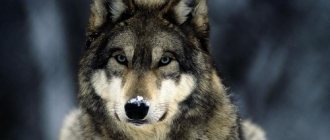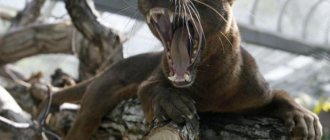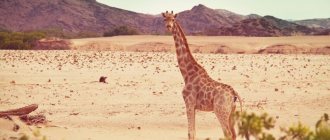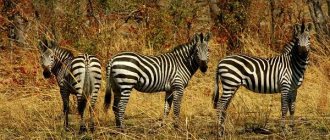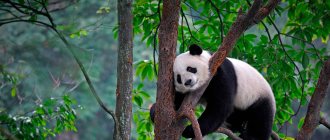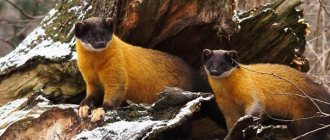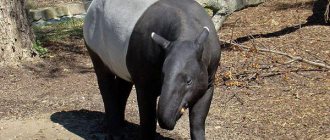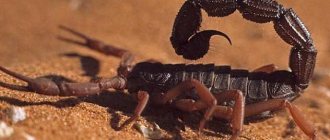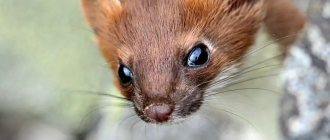The kolonok is a small animal, which in its appearance and genetic code is very similar to ferrets. Because of these similarities, most scientists classify the weasel as a member of the weasel family. In addition to ferrets, the closest relatives of these animals are European minks, and some scientists combine these two species of animals into one. There is also the Sakhalin weasel, which some scientists classify as a separate species altogether and call it itatsi.
Appearance
The kolonok is a fairly small animal, its weight does not exceed 700-800 grams, and the length of its body, including the tail, is from 48 to 66 cm. The body of the kolin is retracted, very flexible and mobile.
The head of the kolinsky is small, the muzzle is pointed, brown in color, which is decorated with white spots near the nose, and a black mask around expressive eyes. There are small neat rounded ears on the head.
The tarsi are short, and there are poorly developed membranes between the toes. The pride of the redhead is its beautiful and fluffy tail, which reaches a length of 18-20 cm.
The Kolinka's coat is reddish-yellow in winter and reddish-red in summer. In winter, the fur is very thick and soft, the kolinsky sheds in March-May, so in summer it seems slimmer, since summer fur is not so thick and fluffy. Moreover, the fur on the tail of the column is more saturated in color than on the back or abdomen.
Where does the kolonki live?
The kolonok lives in Siberia, especially in its southern part, in the Far East, Primorye. In recent years, there has been an increase in the number of weasels in Yakutia, along the coast of the Sea of Okhotsk. Outside Russia, the Siberian weasel is distributed along the slopes of the Himalayas, in most of China, on the Korean Peninsula, and in Japan. Occasionally, the Siberian weasel is also found in the European part of Russia, in the Cis-Ural region.
For its habitat, the Siberian weasel everywhere chooses coniferous or deciduous forests, which must necessarily contain a large number of rodents, which are the main food for the Siberian Siberian. The kolonok likes to settle along the banks of reservoirs, streams and rivers, especially if their banks are overgrown with bushes, with the presence of windbreaks and dead wood.
The Siberian weasel avoids open spaces, but they can easily be found on rocky areas overgrown with bushes. In the mountains it is found up to an altitude of 1500-1700 meters above sea level.
Column can often be found in populated areas, on the outskirts of cities and near fields. Such places attract the animal with an abundance of rats and mice; in populated areas it can sometimes attack poultry or even domestic cats.
Forced migration due to hunger forces the columnar to appear in cities and towns; here it becomes less cautious.
Features and habitat
The kolonok is an animal up to 50 cm long, of which the tail makes up about a third. The animal weighs on average 700-800 g. The body is elongated and is particularly flexible and mobile. Short legs with poorly developed membranes, expressive eyes on a pointed muzzle, small rounded ears.
Beautiful fur is the special pride of a taiga resident. Ocher in color in winter, with a reddish tint, turning to dark fawn when summer comes. The fur on the tail is richer in color than on the back or belly.
The muzzle is decorated with characteristic white spots near the nose and a black mask around the eyes. The silvery color of the feet on the animal’s paws and the light fur of the undercoat highlight the beauty of the fur coat.
The density of the coat varies with the season: lushness and density are typical for the cold period, and in summer the fur is thinner and shorter than in winter. Kolonok lives in the regions of the Far East, the Ural forests, taiga areas of Siberia, Primorye, and Yakutia. Very rare in the European part of our country. They know the speaker in China, Japan, and the Korean Peninsula.
The development of various territories depends on the presence of coniferous or deciduous forests with an abundance of rodents, and reservoirs overgrown with shrubs, with the presence of windbreaks and dead wood. The animal avoids open spaces and loves dense taiga on mountain slopes or along rivers. It is found at elevations up to 1600 m above sea level.
The weasel is found in places inhabited by people, where it is attracted by poultry and the presence of mice and rats. Encountering Siberian weasel in settlements, on the outskirts of cities or near fields is a common occurrence associated with forced migration due to hunger and some loss of caution.
In nature, the animal has many enemies. The main one is the sable, which is displacing its food competitor from the developed territories. The weasel is hunted by feathered predators: hawks, owls, eagles, and eagle owls. You have to hide from attacks by lynxes, foxes, wolves, and ferrets.
Lifestyle and habits
Kolonok leads a sedentary lifestyle. Most often, the Siberian weasel settles in the burrows of chipmunks, voles, tree hollows, under fallen trees, and in dead wood. In addition to the main dwelling, the colonel necessarily has several temporary ones scattered throughout his hunting area, which he uses as needed.
During severe winter cold, the Siberian weasel may not leave its home for several days, falling into a kind of short-term hibernation for several days.
The animals do not mark or defend their territory in any way. Siberians may leave their hunting area due to lack of food, or during the mating season.
The Siberian weasel is mainly nocturnal. The Siberian moth becomes most active during twilight and after sunset. In winter, the animal can be active during the day. In search of food, the animal can travel up to 10 km per night. At night, you can see the glowing reddish eyes of the weaselfish hunting for rodents. On the ground, the animal moves in rapid jumps.
The kolonok is a very dexterous and agile animal, brave, curious, able to climb into crevices and hollows, climb trees and rock tops.
The Siberian weasel can swim well and is able to swim a considerable distance from the shore; water rats, muskrats and river fish often become its prey.
In winter, while hunting for capercaillie and hazel grouse hiding under the snow at night, a weasel weasel that smells birds is able to make its way under the snow to a distance of up to 50 meters and with a swift rush get a bird for itself.
An interesting feature of the columnar is that no matter where he gets his food, he eats it only in his home.
The speaker's voice is similar to that of a ferret: the speaker can chirp and chirp, and when irritated it makes a hissing whistle.
Lifestyle
The speaker, whose photo is presented in the article, prefers a sedentary lifestyle. Only the danger of proximity to natural enemies and extreme lack of food can force representatives of a species to leave a certain territory. Such animals are also capable of migrating short distances while searching for a mating partner.
The Siberian weasel animal always has a main home and several additional ones in nearby areas. These animals usually occupy abandoned burrows of other rodents. The massive roots of old trees also become shelters for them.
The speakers are extremely agile. The animals show increased activity at dusk. It is at this time that representatives of the species go hunting. The weasel animal can be active in the daytime in terms of searching for food. However, this happens most often in winter, when there is famine. In pursuit of prey, speakers are able to move deep into the snow.
Representatives of the species are excellent tree climbers. But such behavior is observed extremely rarely. The animals swim quite well. When changing their habitat, they are able to swim across small mountain rivers.
What does kolinsky eat?
The Siberian weasel is an omnivorous predator. The main diet of the columnar is made up of rodents: mice, voles, hamsters, squirrels, chipmunks, jerboas. When hunting rodents, it pursues them under the snow and in burrows.
Despite its small size, the Siberian weasel can hunt animals that are quite large for it, such as hares.
The Siberian weasel, which can swim well, can get its food in the water by hunting muskrats, catching fish, frogs, and collecting insects and their larvae.
It does not disdain carrion; there are known cases of cannibalism among Siberian Siberians, when a Siberian Siberian Siberian sedum ate another Siberian Siberian Siberian species caught in a trap.
The kolonok can hunt both small birds, such as sparrows, and large ones, such as wood grouse and hazel grouse, approaching them under the snow. In years that are good for nuts and berries, he can enjoy them too.
Hunger forces the snake to migrate, to come close to human habitation, often at this time it makes its way to livestock yards and attacks poultry.
During its hunt, the kolonok quickly attacks its prey, which is different from the sable guarding it.
The Siberian Siberian's main food competitor is the sable; there is severe competition between them for territory, during which, as a rule, the sable displaces the Siberian Siberian weasel from its habitat and the Siberian Siberian has to look for new habitats. You will never meet these two species living next door.
Mammalian nutrition
The Itatsi diet is dominated by river inhabitants, for example, fish, rats, and muskrats. The speakers catch the prey with their tenacious claws. Wood grouse, hazel grouse and other birds are also considered delicacies for the animals. Mammals of this species are very brave and dexterous, so they easily climb rocky and overgrown areas, the tops of trees and rocks, into hollows and crevices.
Siberians also feed on mice, jerboas, chipmunks, squirrels and hares. They do not disdain frogs, larvae and insects. During particularly hungry times, animals can approach people and destroy yards with poultry.
Reproduction
Siberians lead a solitary lifestyle and only form pairs during the mating season, which runs from March to April. At this time, males are fighting for females and fighting fiercely among themselves.
Pregnancy lasts 30-40 days in weasels, and the female gives birth to 4 to 10 cubs. Before the birth of the cubs, the female builds a spherical nest of wool, leaves and dry grass. After the birth of the offspring, the female leads a secretive lifestyle, taking care of the babies. Males do not take any part in caring for the offspring.
Siberian weasel cubs are born naked and blind, weighing only 7 grams. During the first month of life, the mother feeds the babies milk and they grow quickly, their eyes open, fur and a mask appear on their face. Starting from the second month of life, the female begins to feed them with animal food: small rodents and insects.
By the end of the second month of life, the female stops feeding her cubs with milk, and by autumn they already become the size of an adult weasel and begin to lead an independent lifestyle.
The lifespan of a Siberian weasel in the wild is 2-4 years; in captivity they can live much longer, up to 8-9 years.
Kolinsky
Kolonok has a beautiful fur pelt, which is widely used in the fur industry and is popular among clothing designers. In Soviet times, men's fur hats were made from kolinka fur.
Column fur resembles mink and sable fur. The kolinsky is also well known to artists, since soft artistic brushes are made from the fur of its tail, which are called kolinsky brushes.
The density and quality of kolinsky fur depends on the season when it was obtained; winter fur is valued much more than summer fur, the womb is much longer, thicker and softer.
The kolonok is easily tamed and becomes a tame pet. Every year more and more speakers live in people's apartments and houses. There were attempts to breed Siberian weasels on farms for their fur pelts, but these attempts were not continued, since breeding minks was much more profitable from a commercial point of view.
Natural enemies
The Siberian weasel is an animal that large hawks and eagle owls like to hunt. The number of animals that live near human settlements can be reduced by stray dogs. Siberians often serve as prey for foxes and sables.
The animals wage a real feud with the minks. They usually settle in the same area. Representatives of species often participate in fights for territory. Moreover, minks and speakers fight to the last. The winner is the one who managed to stay alive.
